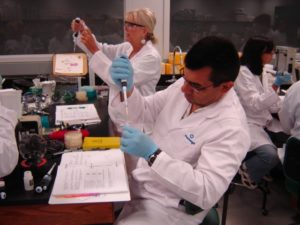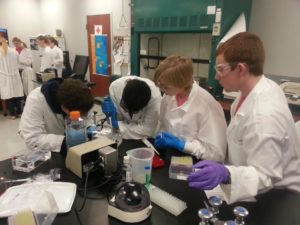 One of the best things about the BTC Institute is that we have programs for all levels of learners. It is as rewarding to introduce the concept of how bioluminescence is used by different organisms in the natural world to middle-school students as it is to have top-level scientists use reporter genes to track their knock-in genome edits.
One of the best things about the BTC Institute is that we have programs for all levels of learners. It is as rewarding to introduce the concept of how bioluminescence is used by different organisms in the natural world to middle-school students as it is to have top-level scientists use reporter genes to track their knock-in genome edits.
We spend a lot of time working over our curricula to determine whether the content meets the learner where they are to allow our students to achieve their goals. We develop activities that let students who comes to us —via field trips, high school courses, non-scientist sessions and graduate level programs—to test ideas and evaluate strategies for problem solving as they learn techniques and concepts central to biotechnology.
In this way we can give all our students a learning experience that allows them to grow as scientists and integrate knowledge based on their experiences. Further, allowing everyone to engage with hands-on techniques brings this science to a diverse set of people, who are in turn able to contribute in their own way to the field of biotechnology.
In a recent session for non-scientists, attendees were able to start with the basics—learning to use a micro pipette—and in the end complete nucleic acid isolation from cells using affinity purification, perform in-vitro protein synthesis and genetically transform cells with luciferase. WOW! These learners come from all areas of industry: human resources, kit packaging and instrument engineering, and they did the same work as bench scientists! They were able to get DNA and RNA from cells, they were able to make a protein in a test tube AND move a gene into bacterial cells and detect the protein that the cells made.
 In a similar sequence of experiments, graduate students in one of our summer programs took brain tissue and isolated total RNA, which they were able to use as a template to compare gene expression using RT-qPCR of a neuro-specific gene (TrkB) versus a reference gene (beta-actin). In addition, they cloned TrkB into bacterial cells and explored ways to determine if a bacterial colony contains an insert and if so, if the insert is their gene of interest as well as the orientation of the insert. They will take their toolkit of new techniques and technical knowledge back to the lab and make amazing discoveries.
In a similar sequence of experiments, graduate students in one of our summer programs took brain tissue and isolated total RNA, which they were able to use as a template to compare gene expression using RT-qPCR of a neuro-specific gene (TrkB) versus a reference gene (beta-actin). In addition, they cloned TrkB into bacterial cells and explored ways to determine if a bacterial colony contains an insert and if so, if the insert is their gene of interest as well as the orientation of the insert. They will take their toolkit of new techniques and technical knowledge back to the lab and make amazing discoveries.
Both lines of experimentation used by these diverse groups involved similar techniques. What these learners did with their hands is comparable, but their ways of thinking may differ significantly, though they could have equal importance. The scientists may go on to demonstrate important connections between genes and proteins, to improve the human condition and that of the environment on planet Earth and beyond. They may make vast contributions to their fields, and we are proud to play a small part in that. We are equally proud to play a small role in giving all people an opportunity to engage more knowledgeably with scientific information that will continue to be more and more technologically advanced, and lastly, to give the many diverse learners that we encounter a chance to experience science in a meaningful way and hopefully both ignite their curiosity and provide them an empowering experience as a scientist, if only for a day.
